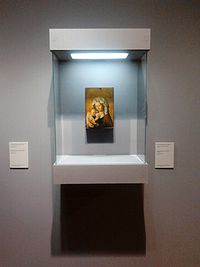
Photo from wikipedia
Wall-displays allow multiple users to simultaneously view and analyze large amounts of information, such as the increasingly complex graphs present in domains like biology or social network analysis. We focus… Click to show full abstract
Wall-displays allow multiple users to simultaneously view and analyze large amounts of information, such as the increasingly complex graphs present in domains like biology or social network analysis. We focus on how pairs explore graphs on a touch enabled wall-display using two techniques, both adapted for collaboration: a basic localized selection, and a propagation selection technique that uses the idea of diffusion/transmission from an origin node. We assess in a controlled experiment the impact of selection technique on a shortest path identification task. Pairs consistently divided space even if the task is not spatially divisible, and for the basic selection technique that has a localized visual effect, it led to parallel work that negatively impacted accuracy. The large visual footprint of the propagation technique led to close coordination, improving speed and accuracy for complex graphs only. We then observed the use of propagation on additional graph topology tasks, confirming pair strategies on spatial division and coordination.
Journal Title: IEEE Transactions on Visualization and Computer Graphics
Year Published: 2017
Link to full text (if available)
Share on Social Media: Sign Up to like & get
recommendations!